... fluffy, flaky, buttery, -&- cheesy ...
I adore cold, drizzly weather; rain falling under a dark sky is like a cozy blanket; a perfect day is one where it rains, and the air is constantly excellent and fresh. Well, to me, at least.
And on days like that, who doesn’t love fluffy, poofy, flaky, buttery Southern biscuits, steaming and hot, 3-4 inches high? Not to mention, stuffed to the gills with melty cheddar and fresh herbs?
Maybe it’s the half of me that’s lived in the American South for a bit, but I adore a fantastic, stacked biscuit smothered in butter or gravy.
Sometimes, biscuits need a bit of ‘oomph!’ or a flair of versatility.
That’s where these cheddar chive biscuits (made with vegan buttermilk!) really hit the SPOT.
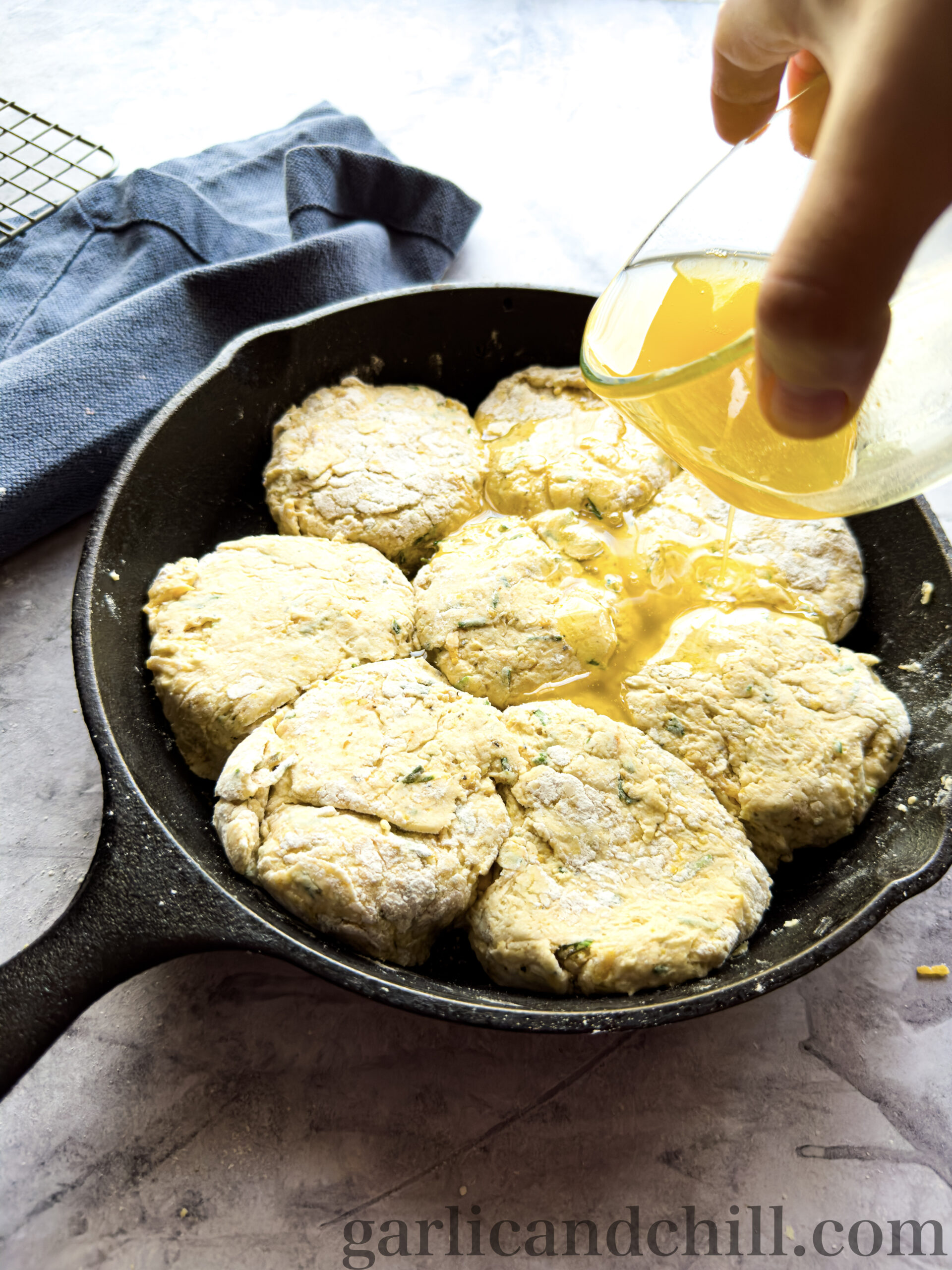
So, I know many people who are intimidated by making Southern American biscuits. I mentioned this advice in the Pie Crust Recipe, but here’s the ultimate all-time secret to making the best biscuits.
The less you worry and stress about it, the better they turn out.
Ergo, the dough senses fear.
So, be confident, fast, and furious, baby; take no prisoners. You’re cooking, the one in charge, and let the dough know it. Put it in its place.
Seriously, trust me on this.
“Okay, where do I start? And what makes them so light and fluffy?”
A few things:
- The Flour. Using Winter wheat-based self-raising flour will eliminate many woes, and it’s all up to technique from there. I’ve been using self-rising flour for biscuits for years, specifically White Lily-brand Self-Rising Flour, but if it’s unavailable in your area, make sure it’s a leavened self-raising flour made from Winter wheat (Summer wheat = higher protein content, more gluten development, denser baked goods; Winter wheat = lower protein content, less gluten development, lighter baked goods). Start with the experts because they have done all the work for you, no guessing how much baking soda/powder to add, etc. It’s one and done.
- Measuring the Flour. Before measuring the flour, I want you to fluff it. Fluffing the flour is far more needed than you might think; there is a vast difference in both weight and volume between measured flour that has vs. has-not-been fluffed and will affect the end product significantly. The more flour packed into the cup, the more flour is used than needed, and the heavier/less fluffy the biscuits will be. So fluff your flour first, spoon it into your measuring cup until it’s piled high, and use a straight edge (like from the back of a knife) to scrape off the excess flour from the cup for a perfect flour measurement every time.
- The Buttermilk. Plant milk + vinegar = hella simple. The best vegan buttermilk is made from high-protein milks (like soy or pea milk). “Why, though? Why not flax, oat, or rice milk?” The high-protein content is necessary for the coagulation we need, which is best with soy or pea milk; it improves overall texture, moistness, bake-rise, and flavor.
- Be Gentle and Fast. You want to use a super light touch but be very fast. Speed is vital, and you barely touch the dough. I mean it, BARELY TOUCH IT. Don’t knead, mix, or overwork the dough. Don’t even think or worry about it. The ingredients/dough does 90% of the work; you’re just there to bring the ingredients together slightly. You’re introducing the wet & dry elements and letting them go, not arranging their date and then going on it with them.
- Leave it Lumpy. When you add in the shortening, you want to quickly break up the fat into small pieces, but NOT thoroughly incorporate it until it disappears. You want lumps – small lumps, but lumps – of fat. This is so that when it’s layered, pressed, and cut, the fat flattens out from lumps into sheets, adding to the flaky separation we all know and love from pulling one apart. You also want the dough itself lumpy or to the point where the liquid has been absorbed, but there is no pile of dry flour mix left.
- Stamp when Cutting. Use a direct up-and-down stamping motion without twisting the cutter when cutting out the biscuits. Turning the blade while cutting ends up binding the dough’s top and bottom together sporadically, affecting how high they rise in the oven.
- Bake Biscuits Directly Next-to/Against Each Other. Biscuits need a little help from their friends, in a sense. When the doughs are touching while baking, they rise and build higher against each other, which makes them want to climb even taller. So, bake them like close friends.
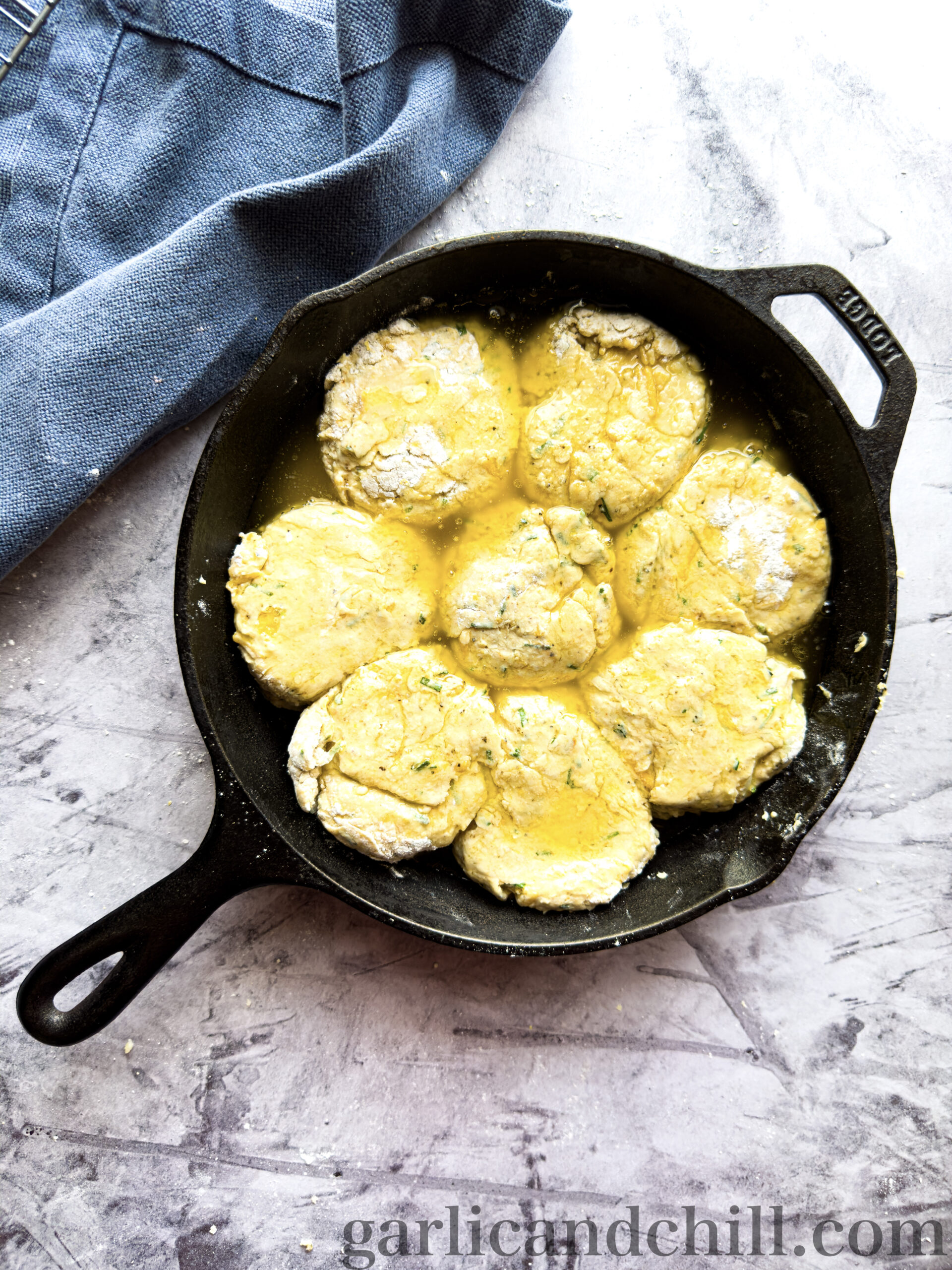
AuthorGinny ClarkCategoryBreakfast, How To, Sides & Extras, Snacky Things
Preheat oven to 450℉.
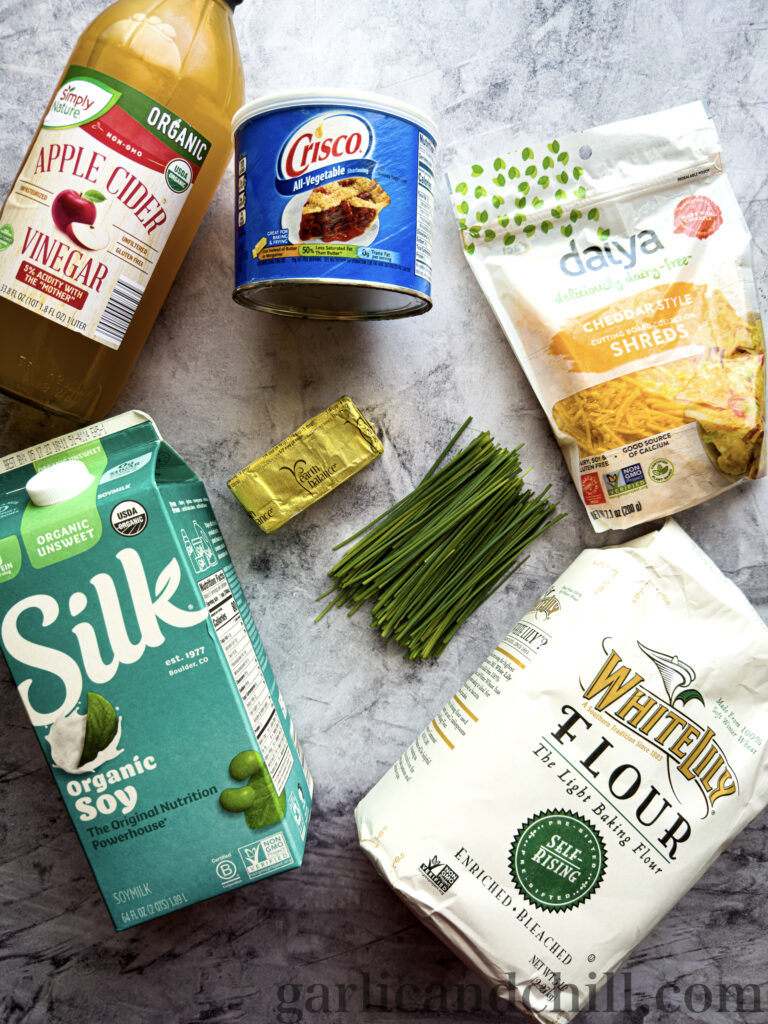
In a small bowl, mix the milk with the vinegar; set aside.
In a separate bowl, melt butter and set aside.
Mince chives finely.
In a large bowl, add minced chives and the rest of the dry ingredients and shortening.
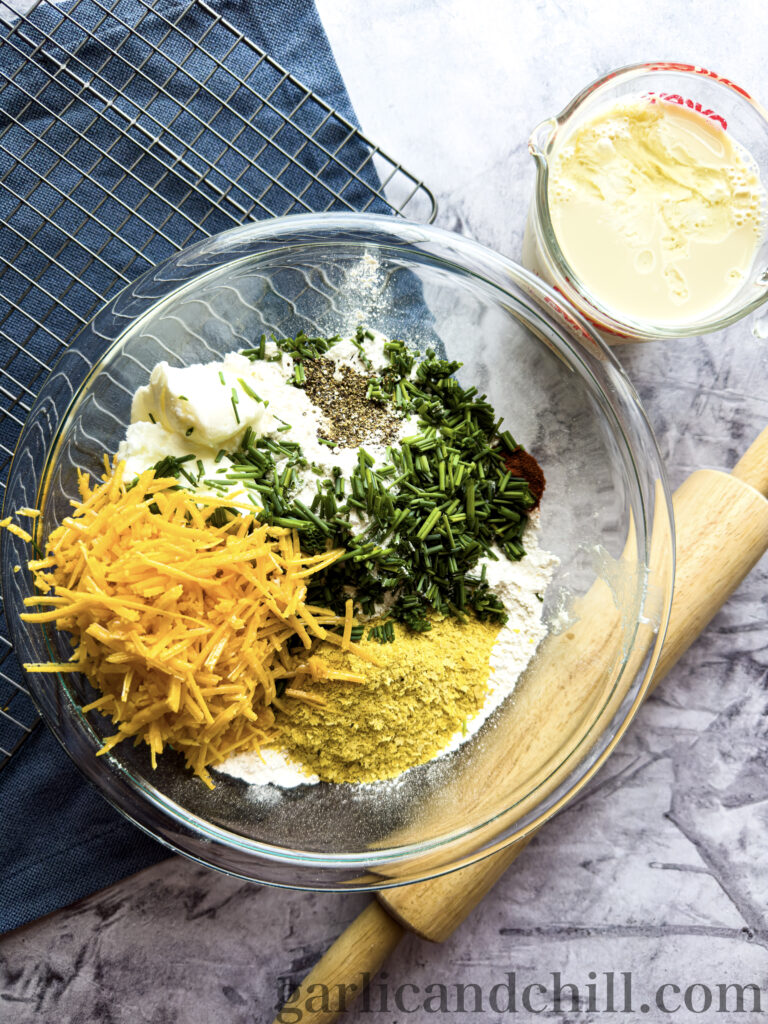
Quickly pinch the shortening while fluffing the dry mix with your fingers. This will break up the fat into smaller pieces (between the size of a pea to a nickel kinda range).
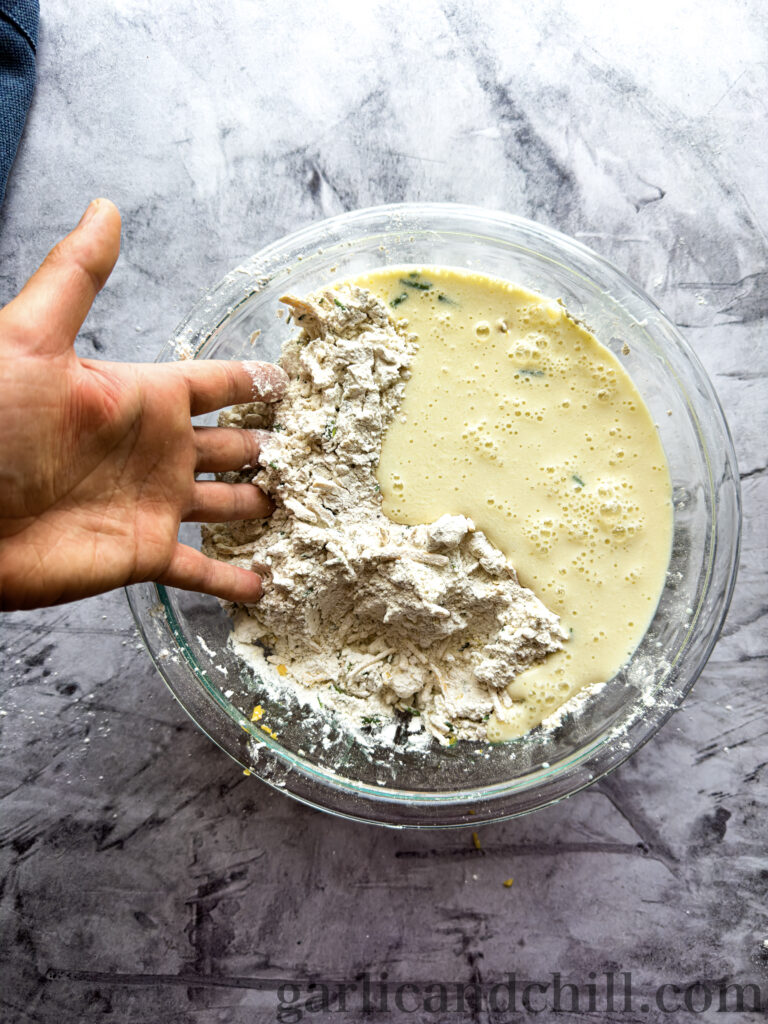
Add the milk+vinegar mix into the bowl.
Do not stir or knead the dough (doing so will make tougher biscuits!); instead, barely bring it together by using open-fingered hands, lifting the dry mix from down around the edge of the bowl to the center. Repeat until there are no more super wet patches and it looks incorporated.
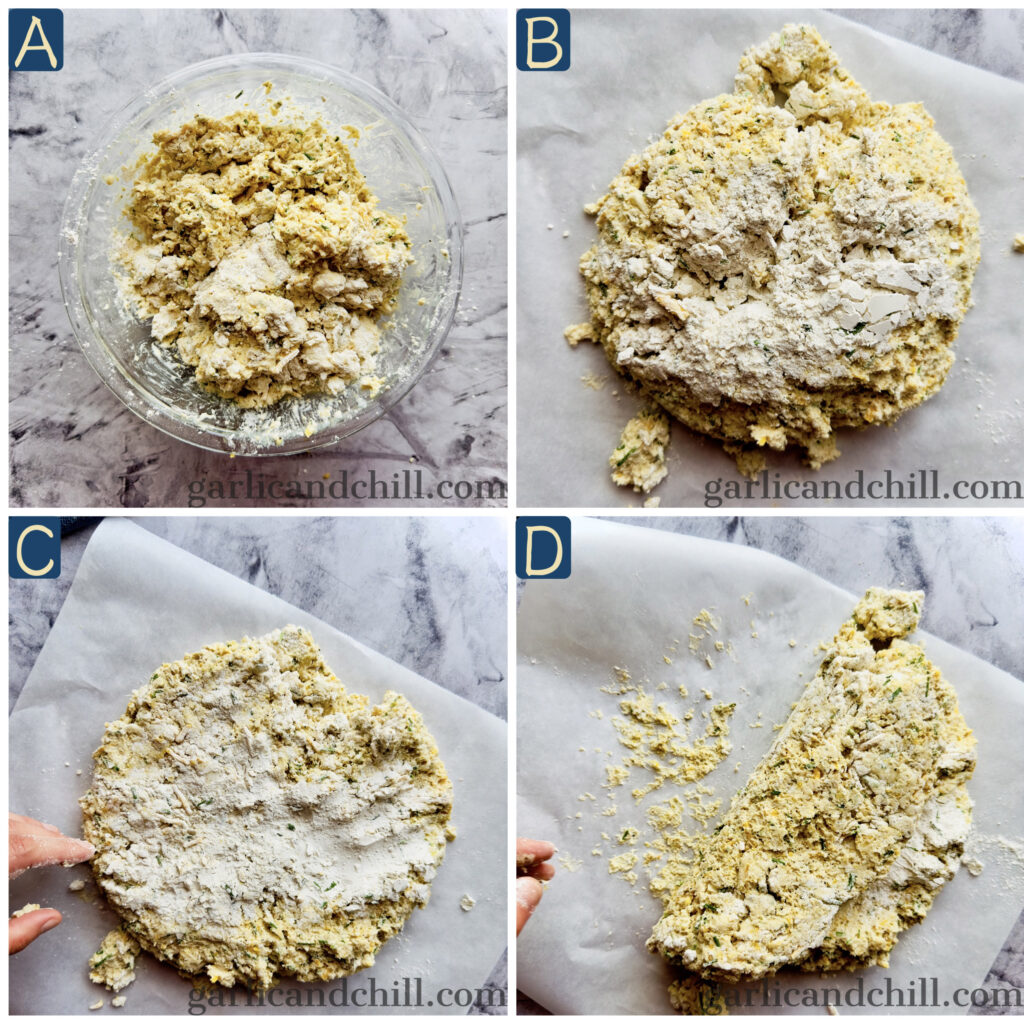
Turn the dough out onto a well-floured counter, and sprinkle the top with flour as well [A-B]. Press dough out into a rectangle, until it’s the thickness/height of your first knuckle (about 1″) [C]. Dust with more flour, and fold into thirds [D-F].
Repeat two more times.
Gently use the weight of a rolling pin to create a more even surface, before cutting [G].
Dust a round biscuit cutter (or 2″-3″ cookie cutter; you could also use a cup if needed!), and in a blunt stamping motion, cut directly up and down without twisting the blade.
Be sure to flour the cutter between each pressing.
When you get down to the scraps, just put them on each other and press out again to cut.
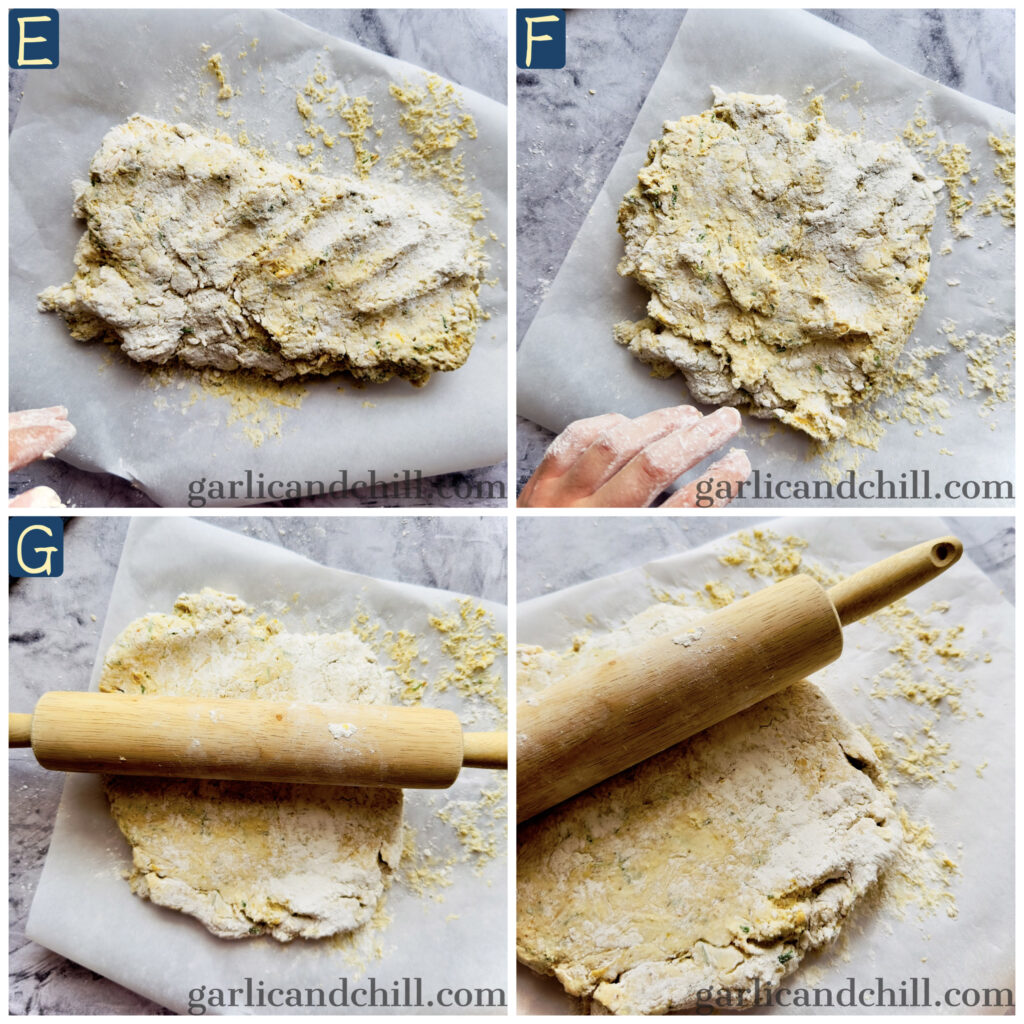
Lay the cut raw biscuit pucks against each other in a dry pan (iron skillet or baking sheet). When the pan is filled, drizzle or brush 1/2 of the melted butter over the top of the biscuits.
Sprinkle some kosher salt on top, if desired.
Bake at 450℉ for 15-18 minutes, rotating 1/2-way through the cooking time.
When done, remove from the oven and coat with the remaining 1/2 of the melted butter.
Let rest for 10 minutes before serving.
Ingredients
Directions
Preheat oven to 450℉.

In a small bowl, mix the milk with the vinegar; set aside.
In a separate bowl, melt butter and set aside.
Mince chives finely.
In a large bowl, add minced chives and the rest of the dry ingredients and shortening.

Quickly pinch the shortening while fluffing the dry mix with your fingers. This will break up the fat into smaller pieces (between the size of a pea to a nickel kinda range).

Add the milk+vinegar mix into the bowl.
Do not stir or knead the dough (doing so will make tougher biscuits!); instead, barely bring it together by using open-fingered hands, lifting the dry mix from down around the edge of the bowl to the center. Repeat until there are no more super wet patches and it looks incorporated.

Turn the dough out onto a well-floured counter, and sprinkle the top with flour as well [A-B]. Press dough out into a rectangle, until it’s the thickness/height of your first knuckle (about 1″) [C]. Dust with more flour, and fold into thirds [D-F].
Repeat two more times.
Gently use the weight of a rolling pin to create a more even surface, before cutting [G].
Dust a round biscuit cutter (or 2″-3″ cookie cutter; you could also use a cup if needed!), and in a blunt stamping motion, cut directly up and down without twisting the blade.
Be sure to flour the cutter between each pressing.
When you get down to the scraps, just put them on each other and press out again to cut.

Lay the cut raw biscuit pucks against each other in a dry pan (iron skillet or baking sheet). When the pan is filled, drizzle or brush 1/2 of the melted butter over the top of the biscuits.
Sprinkle some kosher salt on top, if desired.
Bake at 450℉ for 15-18 minutes, rotating 1/2-way through the cooking time.
When done, remove from the oven and coat with the remaining 1/2 of the melted butter.
Let rest for 10 minutes before serving.
Notes
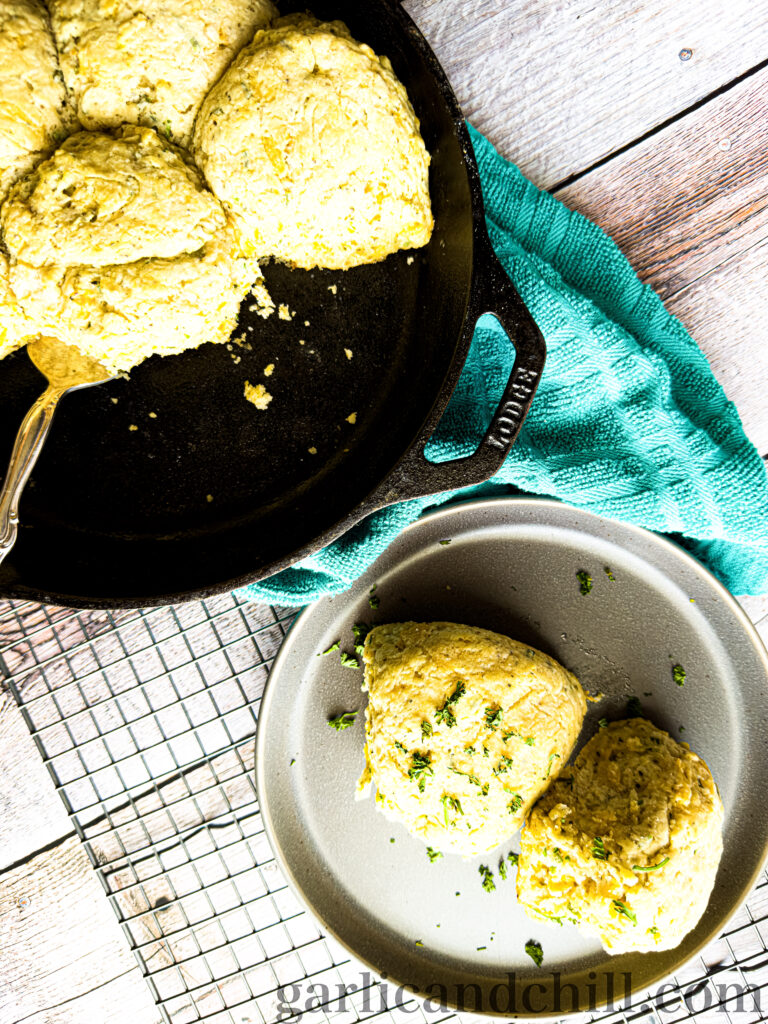


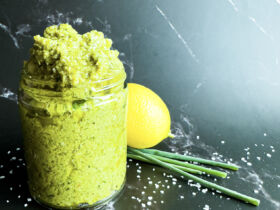
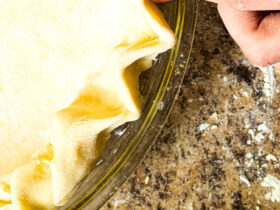
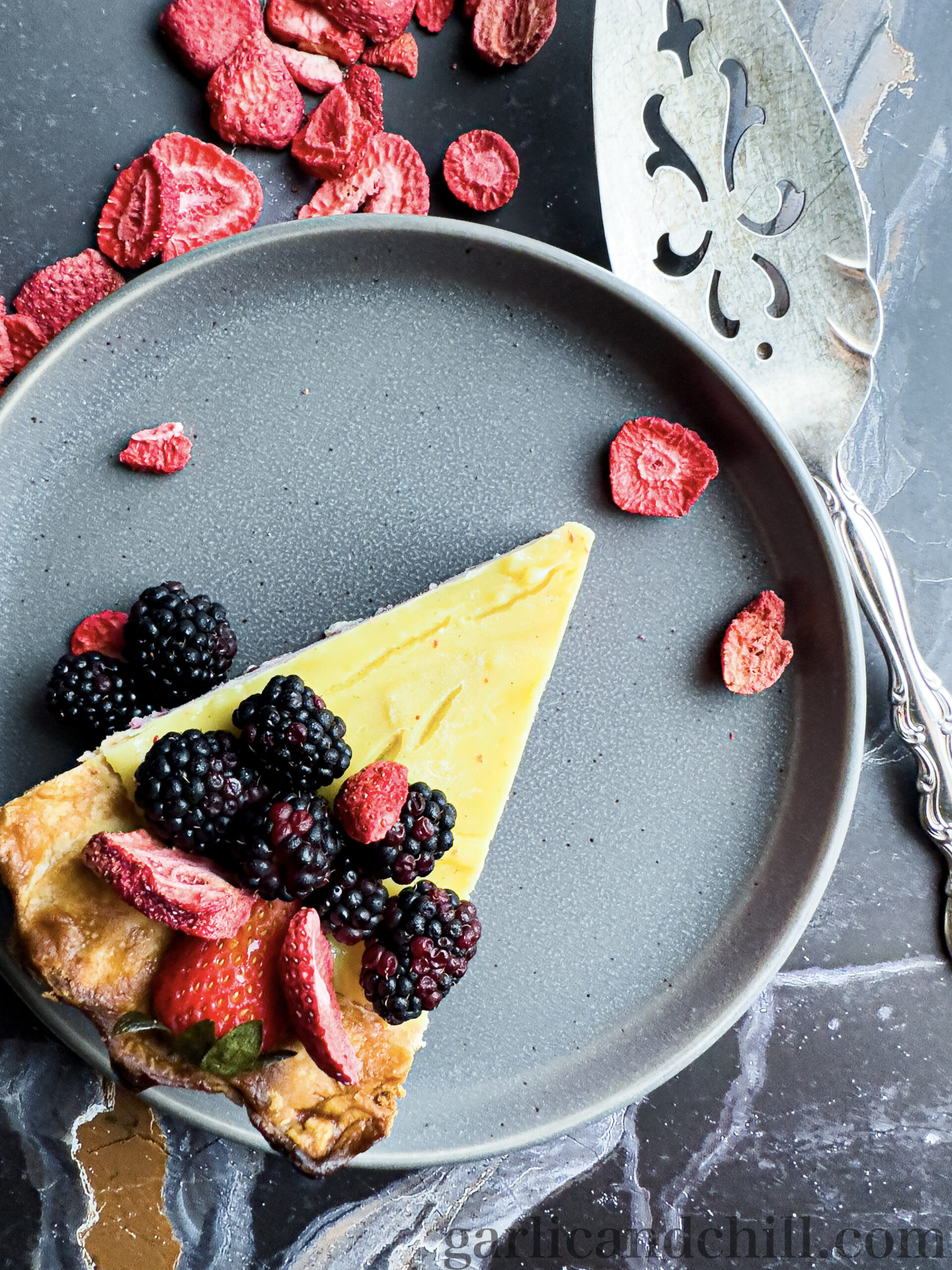
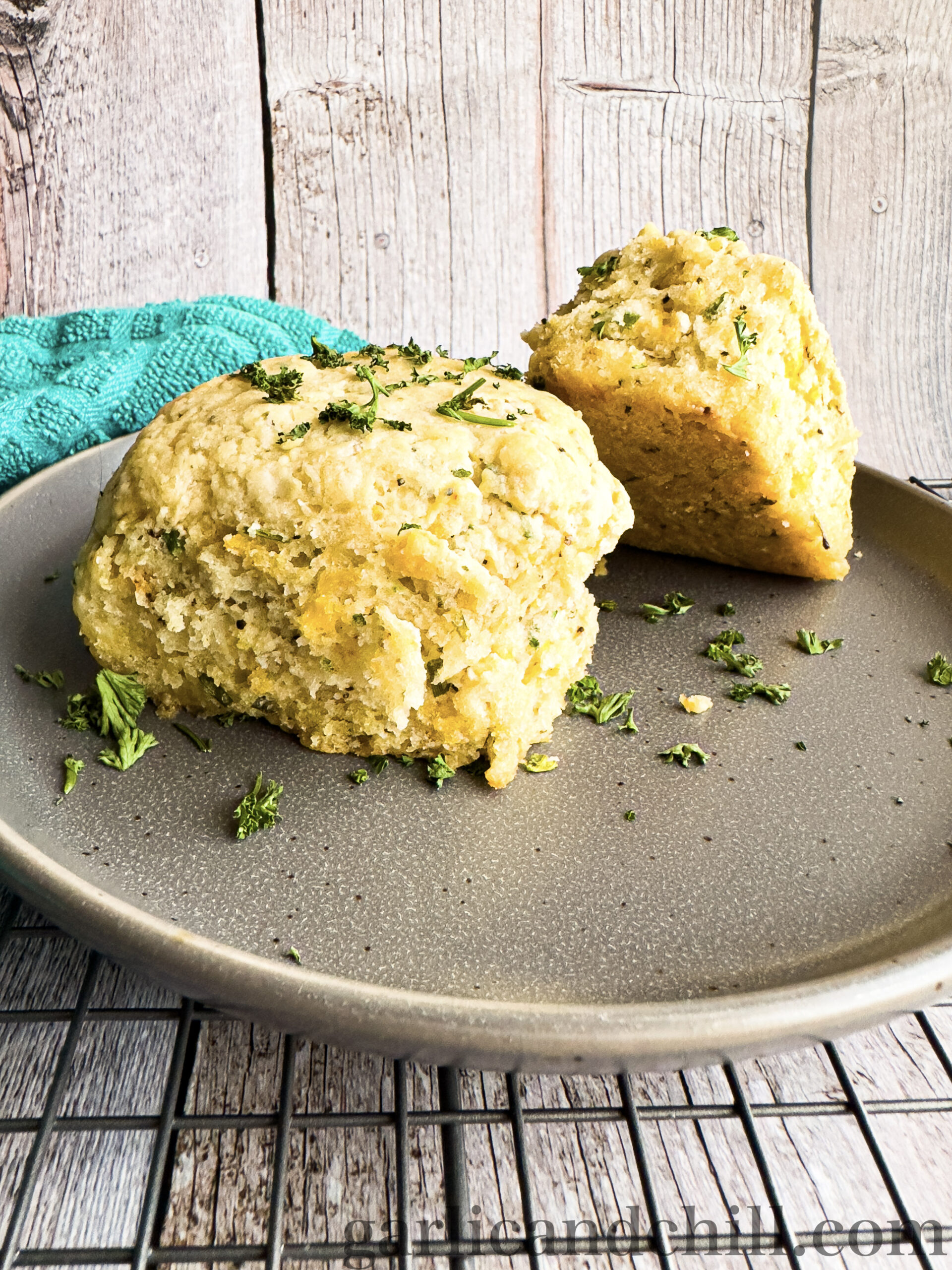
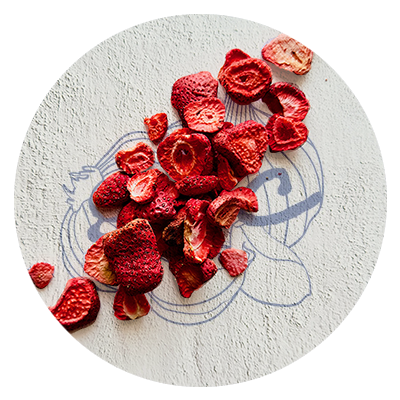
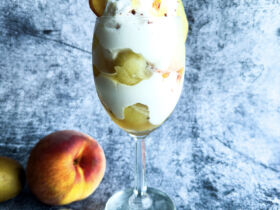
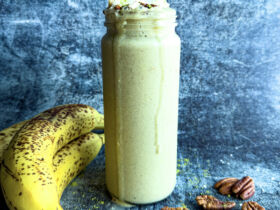
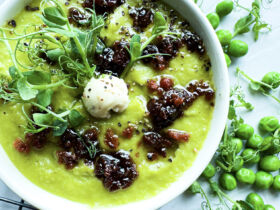
Leave a Reply